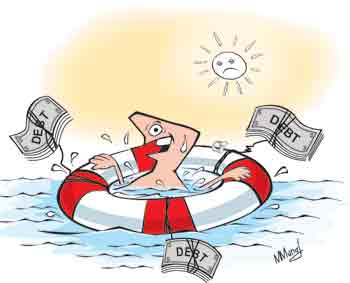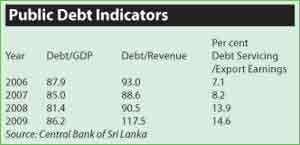The growing public debt and its servicing costs are a severe burden on the economy. It has a detrimental impact on macroeconomic fundamentals that have adverse effects on long term economic development. The large expenditure on debt servicing implies fewer resources for developmental expenditure.
Government borrowing from domestic banking sources to service the debt results in inflationary pressures that destabilise the economy. Increases in the costs of living impose hardships on fixed wage earners and pensioners and often lead to industrial unrest demanding higher wages that increase the costs of production and erodes the country’s competitiveness. The debt servicing cost that is the highest expenditure of the government is itself a factor that increases the fiscal deficit and increases the public debt. The containment of the public debt and debt servicing costs are imperative to break the debt cycle.
Economics of Public Debt
Government borrowing is not necessarily detrimental to an economy. In fact it could be advantageous if the funds borrowed are used for the long term development of the country and gives a return higher than the interest paid on the borrowing. Borrowing is a means of increasing total savings to enable increased investment. Short term foreign borrowing can assist in resolving constraints in foreign resources to tide over temporary balance of payments difficulties such as under the Stand-by Agreement with the IMF. Large development projects that confer benefits in the long run need borrowed funds. Therefore government borrowing is not inherently bad. In fact it could be an important means of spurring an economy to a higher trajectory of economic growth than its current resources permit.
 |
However the extent of borrowing, the costs and terms of borrowing, especially of foreign funds, and most important, the use for which the borrowed funds are put to, have significant implications for macroeconomic fundamentals. These could have either beneficial or adverse impacts on long-term economic development. While borrowing for infrastructure projects that have a long gestation period is justified, debt incurred for wars have been the underlying causes for the decline of many economies.
Even when borrowing is for developmental purposes, such as infrastructure development, large borrowing with a long gestation period can cause inflationary pressures. This is especially so from the domestic currency component of these projects. Moreover, when the additional output that is created does not increase exports or reduce imports, balance of payments deficits can increase. A huge volume of debt however incurred (leading to high servicing burdens, low returns and in sectors that do not generate tradable outputs) removes whatever justification it may have for borrowing by destabilising an economy and affecting the macro economic fundamentals that retard economic development.
Growth of Public Debt
The accumulation of Sri Lanka’s large public debt, comprising both foreign and domestic borrowing, is a result of cumulative fiscal deficits over the years. In the late 1970s and in the early 1980s fiscal deficits were high. In the post liberalization phase the government incurred large foreign debts for developmental purposes and for supporting the balance of payments. However much of the deficits were incurred for development activities such as the Accelerated Mahaweli Development programme. Furthermore, most of the borrowing was on concessionary terms and debt repayment was long term. In spite of this the fiscal deficits were high. In 1980 the fiscal deficit was as high as 9 per cent of GDP.
In latter years war expenditure was mostly responsible for the rising debt. Imprudent government expenditure, large recurrent expenditure and inadequate revenue also contributed to increased fiscal deficits. Furthermore, the government resorted to commercial borrowing at higher interest costs and shorter repayment with practically no grace periods. This has increased the debt servicing burden.
Inadequate revenue and excessive expenditure
The limited revenue base of the government of only about 15-17 per cent of GDP, huge expenditure on public service salaries and pensions, big losses in public enterprises, wasteful conspicuous state consumption, expenditure on subsidies and welfare and the large debt servicing cost itself are causes for the large fiscal deficits. Since current revenue is inadequate to meet the costs of servicing the debt, the government resorts to further borrowing to meet its recurrent as well as capital expenditure. This results in a vicious cycle of increasing debt.
Debt burden
Although the public debt has increased substantially, the debt to GDP ratio has declined owing to increases in the GDP. In 2002 the public debt was 105 per cent of GDP. In 2007 it was 85 per cent; in 2008, it was 81 per cent and in 2009 it was 86 per cent of GDP. In 2010, the public debt is expected to be in the region of 80 per cent of GDP. However, the statistic of the public debt as a proportion of GDP could be misleading, as it does not necessarily convey the massive debt servicing burden.
For instance in 2008, as much as 90.5 per cent of revenue was absorbed for servicing debt. In 2009 the debt servicing cost was 114 per cent of revenue. In 2010 it is likely to be around the same level. The implication of this is that there are inadequate funds for other essential expenditure. Consequently the government has resorted to further domestic and foreign borrowing.
The foreign debt servicing costs have doubled from 7 per cent of export earnings in 2006 to 14.6 per cent of export earnings in 2009. Foreign debt servicing is likely to absorb a higher proportion of export earnings in 2010 and 2011: perhaps nearly 20 per cent. This means that about one fifth of the country’s export earnings are needed to service the foreign debt. The foreign debt component is a strain on the balance of payments owing to the increased commercial borrowing of recent years.
Impact of debt
The cumulative large fiscal deficits over the years have increased the public debt and its high servicing costs generate inflationary pressures that increase the costs of production and erode the country’s competitiveness in international markets. Reduced export earnings imply loss of employment and lower incomes to workers in industries affected, as has happened recently in the garment industry. Large deficits lead to borrowing and in turn to huge debt servicing costs. The massive public debt and crippling debt servicing costs distort public expenditure priorities and hamper economic development.
A large public debt therefore has a serious destabilization effect. Expenditure that ought to have been covered by current revenues has been postponed for future years by borrowing. A huge expenditure such as war necessitates such borrowing. However war expenditure is especially inflationary owing to its magnitude as well as the fact that such expenditure does not produce goods and services for consumption. When such expenditure is over a long period the inflationary impact is endemic.
Summing up
The amount of government debt, the sources of funding the debt, the lack of full disclosure of government liabilities, the massive debt servicing costs and the manner of public expenditure have serious long-term economic and social consequences. Therefore containing the public debt, reducing the fiscal deficits and decreasing debt servicing costs are vital for economic stabilization and long term economic development. This is especially so for a trade dependent export-import economy.
| Comment |
| |
From : Dayaratne
Dear Dr. Sandaratne
You have well articulated the debt burden but missed one important point.
"Foreign debt servicing is likely to absorb a higher proportion of export earnings in 2010 and 2011: perhaps nearly 20 per cent. This means that about one fifth of the country’s export earnings are needed to service the foreign debt. The foreign debt component is a strain on the balance of payments owing to the increased commercial borrowing of recent years."
How about the remittances from overseas which was estimated at $ 3 billion for 2010. Does it not help to relieve the balance of payment dificulties?. I remember you saying in one of your earlier article that the country will not face any serious balance of payment problems? Over to you sir. |
| |
From : Dhananjaya
Thank you Dr Sanderatne for an article written in such a simple , easy to understand style. However, I wish you had elucidated on what the common man and industry should do, as you have summed up purely with common knowledge of what the Govt. should do but would/could not so easily do, for political and other reasons. |
|



